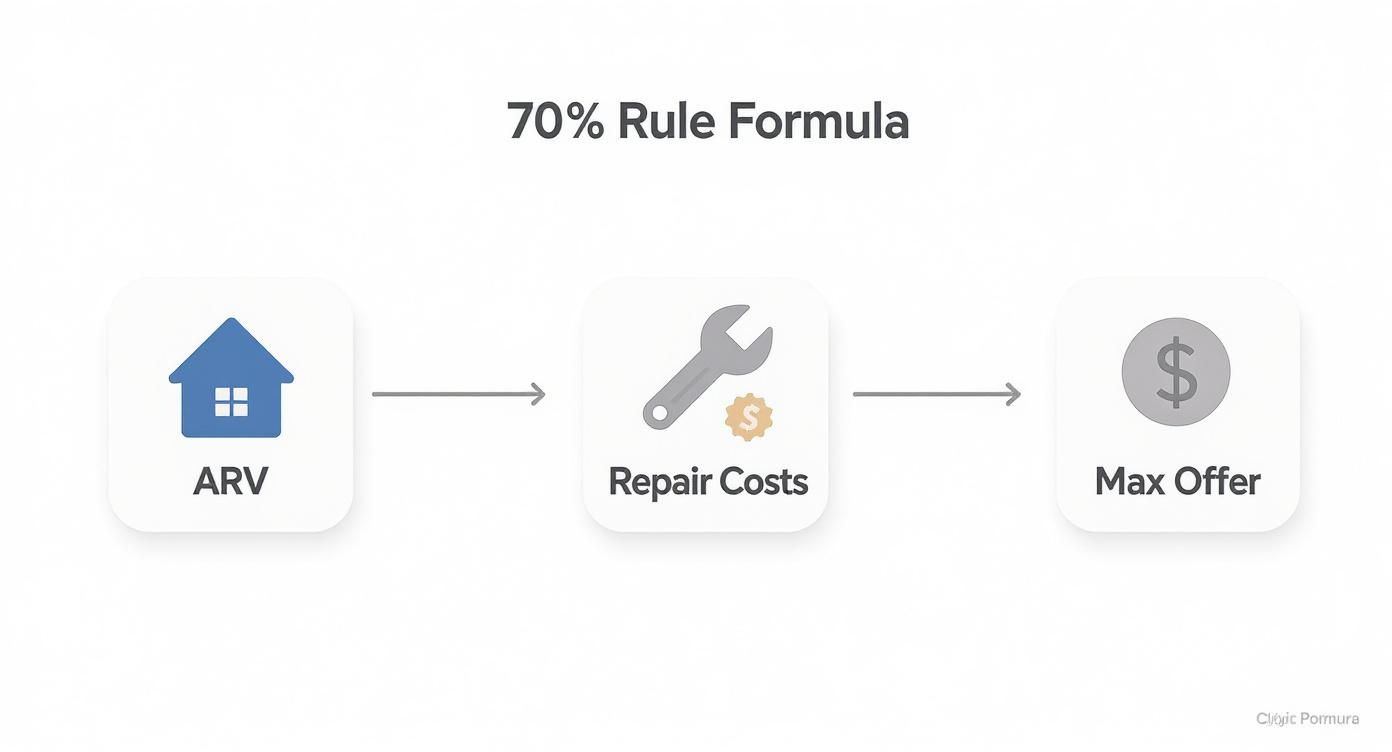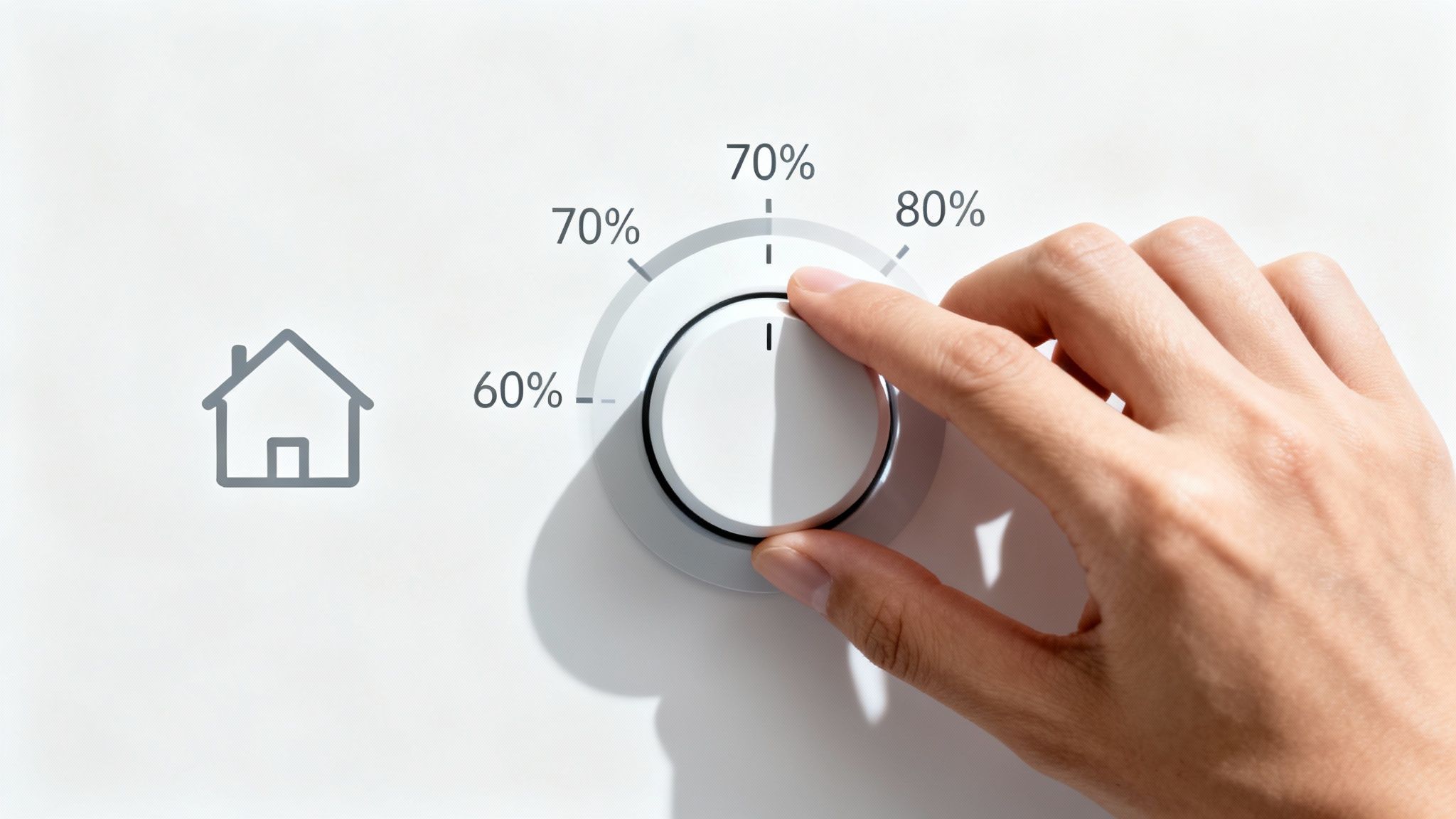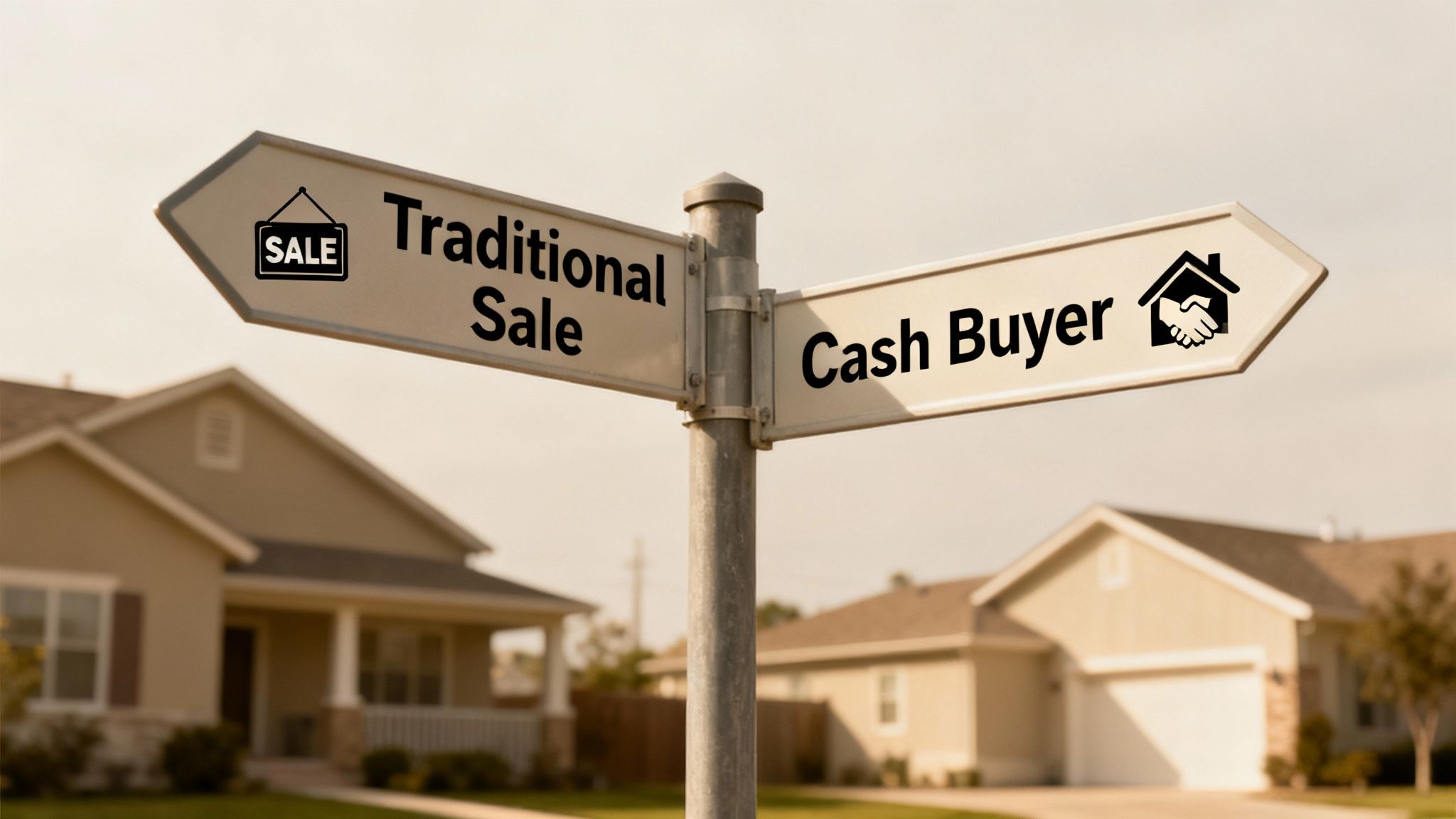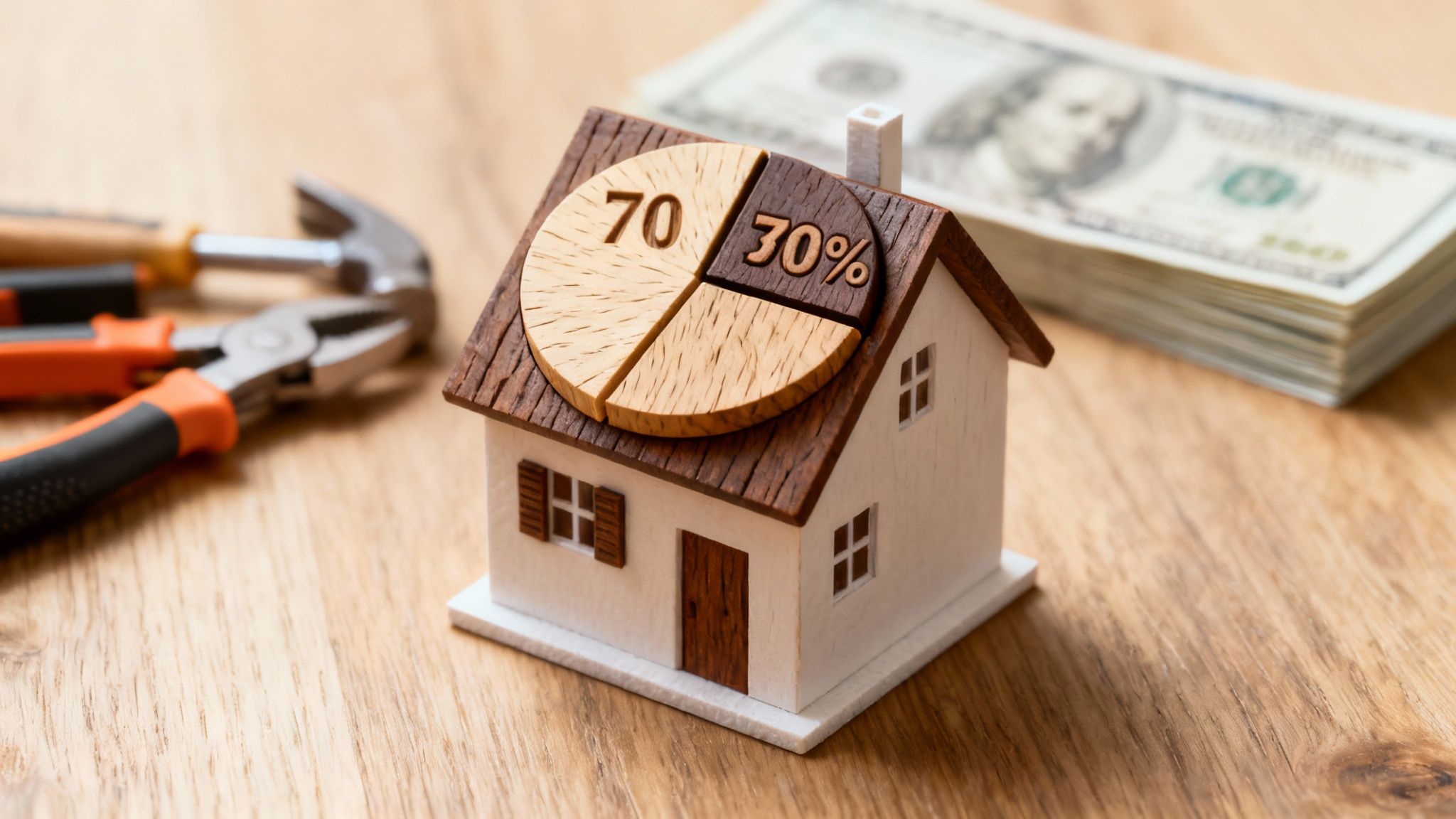The 70% rule in house flipping serves as a quick evaluation tool for real estate investors to determine their highest property acquisition price. The formula is: (After-Repair Value x 70%) – Repair Costs = Maximum Offer. This helps them account for renovation costs, selling expenses, and potential profit before making an offer.
When you receive a cash offer from an investor, it might seem much lower than what your neighbor’s house sold for. This isn’t a random lowball number; it’s often a strategic business calculation, and the 70% rule is the compass guiding it. The tool enables investors to assess property value through maximum purchase price calculation which protects their investment against potential loss.
The Investor’s Blueprint: The 70% Rule Explained
So, what is this rule? It’s a guideline used by house flippers and cash buyers to determine the maximum they should offer on a property.
The formula looks like this: (After-Repair Value x 70%) – Repair Costs = Maximum Offer.
This calculation enables investors to incorporate all upcoming expenses and possible profit margins into their initial investment calculations. The process of buying houses for cash serves as an essential operational principle which creates a unified evaluation system for all transactions.
Decoding the Investor’s Formula
Let’s break down how an investor uses that formula to come up with the number they offer you. Every section of the puzzle serves as an essential building block. The visual representation of their connections helps reveal the complete method to the reader.
The historic New England home renovation project on ‘Flipping Boston 2’ demonstrates how major home improvements affect property market value. That “After-Repair Value” is the number everything else hinges on.
The table below presents a basic explanation of each element in the formula which determines the value of your home offer.
Decoding the 70% Rule Formula
| Component | What It Represents | Why It Matters in Your Offer |
|---|---|---|
| After-Repair Value (ARV) | The estimated market value of your home after all renovations are completed. | The investor aims to reach their final objective by estimating the home’s resale value. Your offer starts here and works backward. |
| The 70% Multiplier | The portion of the ARV the investor targets for their initial budget. | The renovation project yields a 30% gross profit margin which covers all non-renovation costs and generates profit. |
| Repair Costs | The total estimated cost to renovate the property to achieve the ARV. | This is a direct deduction. The more work your house needs, the lower the initial offer will be to account for that expense. |
| Maximum Offer | The final number—the highest price the investor can pay while still making the project viable. | This is the cash offer you receive, calculated to ensure the investor can cover all costs and risks. |
Understanding this calculation shows you that a cash offer isn’t just pulled out of thin air. The process requires careful planning to manage risks properly.
What about the other 30%? That’s not all profit. A critical buffer exists to protect the project from unexpected expenses which include property taxes and insurance costs and realtor commissions and closing fees and renovation cost overruns.
The methodical approach protects the investor from paying too much while benefiting you as the seller. The method guarantees that builders have necessary funding to complete their projects while delivering on their commitment to achieve stress-free and predictable closings.
See How an Investor Calculates Your Offer: An Example
So, how does this 70% rule play out in the real world? Let’s walk through a simple example. An investor tours a property and, based on the neighborhood and recent sales of renovated homes, they determine its After-Repair Value (ARV). The magic number becomes the potential market value of the property after all renovation work has been completed.
Let’s say they determine the ARV is $350,000.
Next, they walk through again, this time with a contractor’s mindset, adding up every necessary fix. The estimated cost to make the home ready for market is $50,000. The two essential elements are now in their possession to perform the calculations.
Breaking Down the Math
With the ARV and repair costs in hand, applying the formula is simple and direct. The goal focuses on financial viability rather than low-cost operations.
($350,000 ARV x 0.70) – $50,000 Repairs = $195,000 Maximum Offer
The $195,000 represents the highest financial boundary they can reach. They can provide their maximum price while maintaining financial stability of the project and safeguarding against all major risks involved in flipping a property. The cash offer you receive will always be less than what your home could sell for because it factors in all upcoming expenses and risks that the investor will take on.
The infographic shows the process of how various expenses are deducted from the final sale price through its visual presentation.

The ARV serves as the foundation for our analysis. From there, both the 30% margin and the direct repair costs get subtracted to land on the initial offer price. The renovation budget is a huge variable, and understanding the average cost to renovate a house helps clarify why this number can have such a big impact on the final offer.
What Happens to the Other 30 Percent?
This is a common question: “Where does the other 30% go?” In our example, that’s a hefty $105,000. The assumption that all profits go to the investor is incorrect.
The 30% operating margin gets consumed by all business operating expenses which are essential for running the business. It’s the investor’s safety net.
Here’s a quick rundown of where that money is allocated: Selling Costs: Once the house is renovated, the investor has to sell it. The buyer needs to pay real estate agent commissions which usually amount to 5-6% of the home’s final sale price. The buyers are required to pay closing costs two times during their purchase process: first when they buy from the seller and then during the resale transaction. The process includes title fees and transfer taxes and legal documentation.
The process of flipping a house takes more time than people usually think. The investor bears financial responsibility for property taxes and insurance and utilities and loan interest during the entire renovation and listing period. These expenses tend to accumulate rapidly.
The “Uh-Oh” Fund: No project is perfect. A portion of the margin is set aside to cover unexpected repairs which may include hidden mold or outdated wiring.
Profit Margin: The remaining sum after paying all expenses becomes the actual profit for the investor. They get paid for their investment of capital and the risk they took and their time commitment.
Getting a handle on this breakdown is a big part of understanding the process of selling a house to an investor. The offer you receive isn’t just a number pulled out of thin air; it’s a carefully calculated figure.
Why Cash Buyers Trust This Formula for Risk Management
A professional cash buyer will base their home offer on market data rather than using random numbers. The 70% rule serves as the fundamental risk management system which supports all their operations.
When an investor acquires a property through direct purchase they face complete financial risk of 100%. The seller faces a major risk because they must handle all problems until the buyer takes possession of the property through the closing process.
The investor is the one who has to worry about lumber prices suddenly spiking, finding a reliable contractor, or the local housing market taking a nosedive. The 30% margin produces revenue that functions as a financial base which protects against all kinds of problems that occur in real estate projects.
The Trade-Off: Certainty for Equity
Selling to a cash buyer presents a clear choice. You’re trading a portion of your home’s potential top-market value for something incredibly valuable: speed, convenience, and certainty. The sale process becomes quick and straightforward because you get paid immediately for your property in its current state without any requirements. The main advantage of selling your house for cash is the direct payment you receive.
For sellers, this means:
- No Repairs: You don’t have to spend a dime fixing up the property.
- No Fees: You avoid paying agent commissions and other closing costs.
- Speed: You can close in a matter of days or weeks, not months.
The process works well for people who want to sell their home quickly without any problems. The process provides a definite closing date and immediate payment which frees you to start your new life without dealing with the typical home-selling process.
The 70% rule has a long track record, especially in stable urban and suburban neighborhoods with older housing stock. Investors in these regions between 2010 and 2020 consistently acquired properties at 60-75% of ARV which aligns with this formula. The real-world application of this concept becomes clear through Rocket Mortgage.
A Shield Against the Unknown
Every house flip is a gamble. An investor who removes walls will discover expensive repair needs when they encounter foundation cracks or mold or outdated electrical systems.
That 30% margin is specifically designed to absorb these unexpected financial blows.
Without this built-in protection, a single bad project could easily put a small investment company out of business. The 70% rule exists to help investors create sustainable business models which enable them to continue assisting homeowners.
The table below breaks down the major differences you can expect when choosing between a traditional market sale and a cash offer from an investor.
Comparing Your Selling Experience
| Factor | Traditional Market Sale | Investor Cash Sale |
|---|---|---|
| Speed | 30-90+ days to close | 7-14 days to close |
| Certainty | Deals can fall through (financing, inspections) | High certainty, firm offer |
| Repairs | Often required by buyers | None required (sold “as-is”) |
| Showings | Multiple showings and open houses | One brief walk-through |
| Fees & Costs | Agent commissions (5-6%), closing costs, repairs | No commissions or fees |
| Offer Price | Potentially higher, but not guaranteed | Lower, but guaranteed and net |
Ultimately, it comes down to a simple exchange. The investor handles the work, the cost, and the risk. The seller receives a fast and easy transaction process in exchange. The 70% rule is just the math that makes that exchange fair and possible for both sides.
When Investors Bend the 70% Rule
Think of the 70% rule as a trusty rule of thumb, not an unbreakable law. Any experienced investor knows it’s a fantastic starting point for analyzing a flip, but the real world requires flexibility. To come up with a fair cash offer that works, they have to adapt.
The search for projects using a fixed number approach leads to two possible outcomes: either missing out on great opportunities or selecting projects that will lead to failure. Smart investors adjust their investment approach by analyzing risk levels and market opportunities and local market conditions.

This is where experience really comes into play. A savvy buyer knows their formula has to breathe.
Adjusting for Market Conditions
The local real estate market is the biggest variable of them all. An investor’s entire calculation can stretch or shrink based on how hot—or cold—the market is.
-
Hot Seller’s Market: When houses are flying off the market and prices are rising, investors can afford to be more aggressive. In a bidding war, they might push their formula to 75% or even 80%. Why? Because the risk of the house sitting empty for months is low, justifying a higher offer.
-
Cool Buyer’s Market: On the flip side, if homes are lingering for months and prices are flat, caution is the name of the game. The risk of getting stuck with high holding costs skyrockets. To build in a bigger safety net, an investor will likely dial back their formula to 65% or even less.
Factoring in Property Type and Risk
Houses come with unique risk profiles because no two homes share identical characteristics. Different pricing strategies apply to entry-level homes versus luxury estates because they belong to separate market categories.
The high-end property with expensive mortgage payments and high taxes and limited buyer interest creates an entirely new market. The investor would apply a 60% rule here because the investment carries substantial risks and the resale period stays uncertain.
The size of the renovation project stands as a primary determining factor. A light cosmetic refresh is one thing. A full gut job with new plumbing and electrical is something else entirely. The more complex the rehab, the more an investor has to cushion their offer to account for the inevitable surprises lurking behind the walls. The ability to adapt this simple formula enables it to become a powerful tool which works effectively in actual situations.
Which Selling Path Is Right for You?
The 70% rule and investor cash offer calculations are now familiar to you. The information goes beyond basic facts since it provides readers with valuable knowledge. Understanding the numerical structure of an offer enables you to evaluate your choices clearly which leads to the best decision for your situation.
Think of it like this: you’re at a fork in the road. One path is the traditional route, and the other is a direct off-market sale. The two methods will help you sell your home but they follow completely different paths to reach the same goal.

Path #1: The Traditional Market Sale
This is the route most people know. You hire a real estate agent and list your home on the open market, aiming for the highest possible sale price. The path to success needs your active participation through time and financial resources.
Here’s what that journey usually looks like:
- Making Repairs: You’ll probably need to fix that leaky faucet, update tired kitchen fixtures, and boost your curb appeal to catch the eye of discerning buyers.
- Staging and Showings: This means getting your home picture-perfect for photos and being ready for a parade of strangers to tour it, often with very little notice.
- Dealing with Uncertainty: It’s common for deals to hit snags. A buyer’s financing might fall through, an inspection could uncover issues, or an appraisal might come in lower than the offer price.
- Waiting It Out: From listing to closing, the process can easily stretch on for months.
This path is a great choice if you have the time, money, and patience to chase that top-dollar figure.
Path #2: The Direct Cash Sale
The other path is selling directly to a cash home buyer. This route is built for speed, simplicity, and certainty. Instead of aiming for the highest theoretical price, you get a firm, net offer—the exact amount of cash you’ll walk away with. Companies like Eagle Cash Buyers specialize in this type of transaction.
Here’s what you can expect on this path:
- Incredible Speed: We’re not talking months; we’re talking weeks, sometimes even days.
- No Repairs, Period: You sell your house completely “as-is.” No fixing, no cleaning, no hauling junk out of the garage.
- Zero Fees or Commissions: The offer you get is the cash you receive. You won’t see a dime deducted for agent commissions or surprise closing costs.
- A Guaranteed Close: Cash buyers use their own funds, so there’s no risk of a bank pulling the plug on a loan at the last minute. The deal is solid.
This option is a lifesaver for homeowners who need a fast, stress-free sale without any of the usual hassles. Our guide about cash buyer versus Realtor listing will show you how to compare these two methods effectively. The guide presents all information through direct comparisons.
At the end of the day, there’s no single “best” choice—only what’s best for you. Are you after the absolute highest price, no matter how long it takes? Or do you need a simple, guaranteed sale that lets you move on with your life right now?
Whether you’re moving for a new job, dealing with an inherited property, or just can’t stand the thought of endless open houses, knowing your options means you can move forward with confidence.
Get Your No-Obligation Cash Offer
Now that you have a behind-the-scenes look at how investors calculate their offers, you’re in a much stronger position to weigh your options. The 70% rule functions as a financial model which enables fast cash sales while avoiding typical market complications and extended waiting periods.
The best way to see if this path makes sense for you is to see the actual numbers for your property.
The process of getting a cash offer is easy and stress-free while it delivers actual market value for your property. The number you get serves as a reliable benchmark for traditional listing results which helps you make an informed choice. Our system provides a simple way to determine an honest and transparent cash offer for your home.
At Eagle Cash Buyers, the process is built for simplicity and certainty:
- No Repairs: Forget the contractor quotes and weekend projects. We buy your house exactly as it is today.
- No Showings: Just one quick, respectful visit. No need to keep your home picture-perfect for strangers.
- No Fees: We don’t charge commissions or hidden fees. The offer we make is what you walk away with.
- Your Timeline: You’re in control. Pick the closing date that fits your schedule, not someone else’s.
Take the first step and see how you can sell your house for cash on your own terms by requesting a free, no-obligation cash offer.
Answering Your Questions About the 70% Rule
Even after seeing the formula, you probably still have some questions about how all this plays out for your specific property. That’s completely normal. Getting a handle on the details is the best way to feel confident when you get a cash offer.
Let’s walk through some of the most common questions we hear from homeowners.
How Do Investors Figure Out the After-Repair Value?
This is a great question. The After-Repair Value, or ARV, isn’t just a guess. An investor finds it the same way a real estate agent would: by running the “comps.”
Comps are comparable sales—homes in your immediate area that have sold recently. The key is that investors look for homes that are similar in size and style to what yours will be after it’s fully renovated. The evaluators base their assessment on move-in-ready homes which sets a data-driven benchmark for the home’s future market value.
What Exactly Goes into the Repair Cost Estimate?
The estimation process demands investors to perform an extremely detailed evaluation of the repairs. The evaluation process goes beyond surface-level changes. Their budget has to cover every single thing needed to get the house to that top-dollar ARV.
You can expect their estimate to include things like:
- Big-Ticket Systems: Is the HVAC on its last legs? Does the roof have a few years left, or is it time for a full replacement? The estimate will include costs for plumbing and electrical systems.
- Structural Fixes: This covers the serious stuff—foundation problems, wood rot, or anything else that compromises the home’s integrity.
- The homeowner will need to remodel their kitchen and bathrooms and install new floors and modern lighting and appliances throughout the entire house.
- Curb Appeal: First impressions matter. The budget will include landscaping, siding repairs, new windows, and anything else needed to make a buyer fall in love from the street.
An investor’s repair budget is so detailed because once they buy the house, every single one of these problems becomes their responsibility. A lower offer on a house needing a ton of work simply reflects the massive cost and effort required to bring it back to life.
Can I Negotiate an Offer Based on the 70% Rule?
Absolutely. While the core formula is pretty standard, the numbers that go into it can sometimes be discussed. Negotiation usually works best when it’s about the facts.
The investor will use comps from nearby renovated homes which have sold for amounts exceeding their ARV estimate. The repair list shows a new furnace but your furnace was replaced last year so you should bring that up. The business model includes an undisputed 30% gross margin which serves as a built-in buffer for all costs and unexpected risks.
The offers from Eagle Cash Buyers follow a specific formula which matches the reality of house flipping.
If a fast, as-is sale with zero hassle sounds like it fits your needs, the next step is easy. Find out exactly what your numbers look like by requesting your free, no-obligation cash offer today. Get the data you need to make the right choice for your situation. Learn more at https://www.eaglecashbuyers.com.





